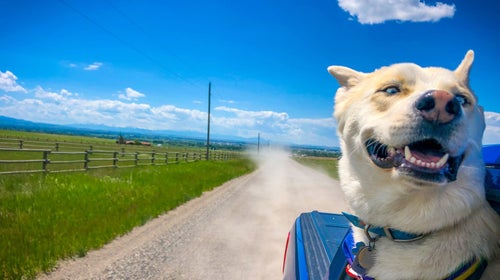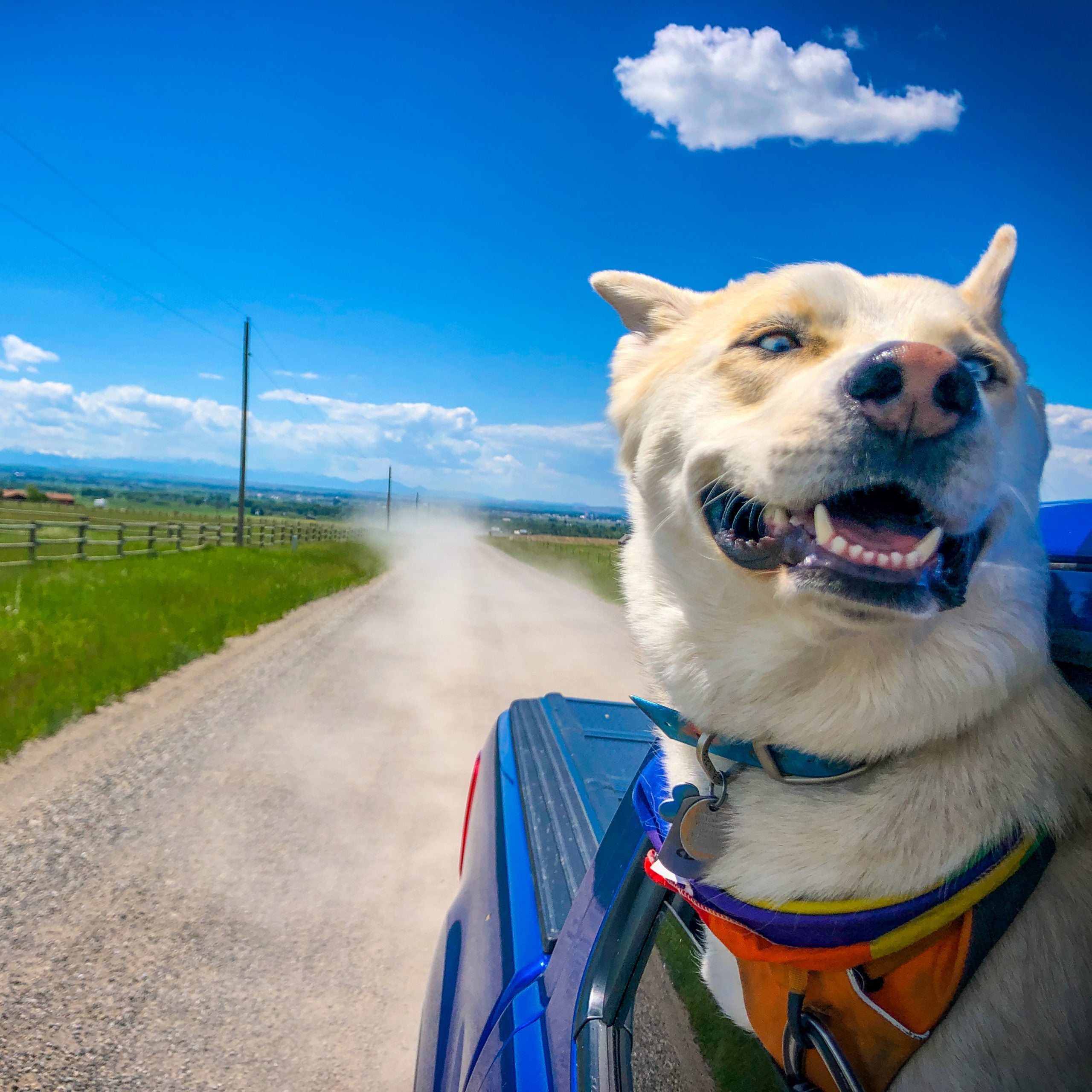Hanging out with your dogs somewhere beautiful is pretty awesome. Getting them there, particularly if that beautiful spot is a long way╠řaway, is less awesome. Because three large dogs follow me around everywhere I go, this is a problem I frequently have. HereÔÇÖs how I make road tripping╠řwith my dogs a reasonably stress-free experience.
Get Your Dog Comfortable with╠řCar Rides
As with all things dog, raising╠řa canine╠řcapable of calmly riding in a car is going to be easier the earlier in their lives you╠řstart╠řacclimating them to it. From four to twelve╠řweeks of age, puppies go through a crucial socialization period╠řin which they soak up new experiences, learn their place in the world, and adapt to different╠řenvironmentsÔÇöand car rides are no different from learning not to be scared of loud sounds╠řor to be cool with children. Begin with small, highly managed experiences, and scale them slowly over time.
To start, enlist the help of a friend, and ask them to drive you around the block a couple of times while you cradle your puppy in your arms. Give the dog╠řtreats and praise╠řin an effort to connect the experience with positive reinforcements. Once your pup is╠řable to ride around calmly for, say, five minutes, try ten. You get the idea.
The connection between positive reinforcements╠řand an experience clicks super fast in a puppy. It takes older dogs╠řlonger to feel comfortable with╠řnew things, but the method remains exactly the same.
Give Your Dog a╠řSpot of Its Own
Keeping your dog calm and confident will be easier if you give it a regular place in the car. You can introduce that spot with a familiar blanket, bed, or toy, and over time, your dog will come to understand that, for example,╠řthe right rear seat is where it belongs. That will also help keep your dog from hopping around the car╠řor feeling like itÔÇÖs doing the wrong thing.
How much space does your dog need? Probably less than you might expect. I pack╠řthree large dogs into╠řthe back seat of my midsize Ford Ranger without issue. Wiley lies╠řon the floorboards, Teddy takes up the entire back seat, and both growl at Bowie if he tries to sit in either area. See? No problem.
In all seriousness, just plan out a space in your car thatÔÇÖs about the same size as whatever kind of bed the dog sleeps on at home. When in doubt, go smaller rather than larger. Tight confines help the dog stay stable, which seems to make them happier.
Provide Food and Water
I try to keep╠řmy dogs on the same rough schedule theyÔÇÖre on at home. That means I feed them once, around midafternoon. This helps keep╠řthe timing╠řof their energy spikes, poops, and complaints about nearly starving to death as predictable as possible.
I feed my dogs a healthy raw-food diet╠řcomposed mainly of╠řchicken drumsticks, along with some extra supplements, organs, and vitamins. ItÔÇÖs actually really╠řeasy to keep that diet consistent on the road. Just freeze the meals in individual serving-size baggies before you leave, then pack those individual meals into╠řa cooler or portable fridge-freezer. Since youÔÇÖre feeding them human food, you can restock at grocery stores along your route.╠řA container of Lysol and a little bottle of hand sanitizer will help you avoid germs.
ThereÔÇÖs a variety of supposedly spill-proof water bowls out there, but IÔÇÖve never found one that works, especially given the off-road nature of most of my road╠řtrips. So╠řI just try to offer my dogs a fresh bowl of water every time we stop. If they empty it, I refill it until they stop drinking. A couple of reusable gallon jugs are the easiest, cheapest way to carry water for your pups.
Time Bathroom Breaks
A puppy needs a bathroom break at least once an hour. An older dog might be happy going four hours or more without stopping. You likely already know the rough frequency your dog requires from all those walks you give it. Just be aware that time spent in unfamiliar environments, with unfamiliar╠řstimuli, can make even the most regular dog unpredictable, so╠řmonitor them for signs of pacing, excessive panting, or whining that may indicate a need to visit a roadside bush.
Avoid Danger
YouÔÇÖre going to╠řstop at gas stations, so those might seem like convenient places to give your dog a bathroom break. Unfortunately, all the gasoline, oil, antifreeze (which is both poisonous and sometimes tasty to dogs), and other chemicals tend to spill╠řover gas station forecourts. Either keep an eye out for that stuffÔÇöand keep your dogÔÇÖs paws away from itÔÇöor wait until youÔÇÖve finished filling up╠řand move your car adjacent to a grassy or wooded perimeter to give them a safe place to go to the bathroom.
The other big danger on road trips is heat. We all know dogs die in hot cars, but a lot of us are still guilty of underestimating how fast that can happen. If your vehicle can be left locked while running, you can safely leave your dogs inside it with the air-conditioning going. Just read your ownerÔÇÖs manual to╠řfind out╠řhow long it will run before turning itself off, and make sure you return to your car well before that time is up. Even then╠řI wouldnÔÇÖt leave my dogs unattended in a locked car for longer than a quick run into a store.
To avoid the risk altogether, pair one of my braided climbing rope leashes with locking carabiners and , and tie your dogs up in a shady spot╠řwith a bowl of water.
Any time theyÔÇÖre around traffic, dogs are also at risk of being run over. For this reason, I always keep my dogs leashed while they ride in cars. IÔÇÖm also careful to keep the windows raised enough so that the dogs canÔÇÖt squeeze out, and that all doors shut whenever╠řthey arenÔÇÖt in use.
I explored restraints, barriers, crates, and other dog-safety devices at length in this article.╠řPlease donÔÇÖt ever carry a dog in the open bed of a pickup truck; itÔÇÖs estimated that╠ř are killed falling from pickup beds each year in this country. And╠řeven inside a capped bed, dogs can be subject to extreme temperatures.
Find the Perfect Place╠řto Stay
Because I like to take my dogs to faraway places, IÔÇÖll drive, rather than fly, even on long trips. That means I often find myself with the need to crush highway miles for days at a time. My formula for maximizing those distances╠řwith dogs in tow is to drive until IÔÇÖm tired, then find a Motel 6 to crash in. All Motel 6 locations are universally dog friendly, with no extra fees. And youÔÇÖll find one at most╠řmajor highway exits in America.
The site╠ř can help you track down╠řother options, either along your way╠řor at your destination. Note that╠řjust because a hotel has some dog-friendly rooms listed, that does not mean a dog-friendly room will be available. It is always a good idea to call ahead. IÔÇÖve also written more about the responsibility a dog owner takes on╠řwhen╠řbringing their dogs to hotels.
The best way to travel with dogs, though, is simply to camp. By driving down dirt roads into a national forest or onto BLM land, or by visiting other types of public land, you can find a pretty place to spend a night, often in an area where your dog is welcome to run around off-leash. And, man, do dogs like to camp. (I explained how you can freely camp across the 640 million acres of public land we all own.)
This is probably the place to note that most national parks are not great places to take dogs. Even those╠řwhere dogs are allowed only tend to allow them in front-country areas and developed campgrounds. National parks are special, uniquely fragile places. I leave my dogs at home when I visit them.


